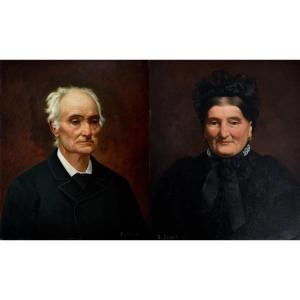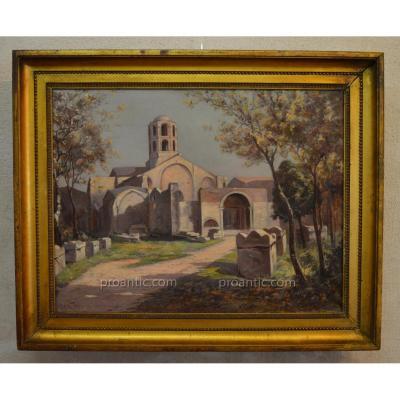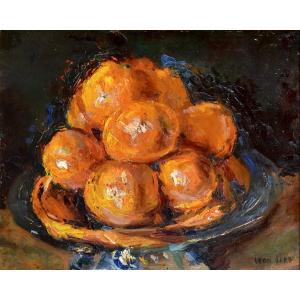"The Chalet in the Snow"
Oil on canvas, Signed lower left, Exhibition number "110" lower left,
Titled on the stretcher: "Chalet in the Snow / Chalet in Spring",
Various exhibition or reference numbers on the stretcher,
A catalogue raisonné on the artist will be included with the work.
A beautiful work by the post-impressionist painter from Fougères, Emmanuel de La Villéon, depicts a view of a chalet under the snow, most likely in Bel-Air, Switzerland, where the artist loved to paint.
A figure can be seen walking along the path leading to the wooden chalet, as the last snowflakes of spring in Switzerland fall in the park and accumulate on the tree branches.
The artist uses a light and colorful palette in shades of blue, pink, and purple, playing on the play of light cast by the sun and the reflections in the snow.
Born into an old aristocratic Breton family, Emmanuel de La Villéon devoted his life to painting. He left Fougères in 1880 for Paris, where he entered the Académie Julian. He trained in outdoor painting alongside his friends Alfred Roll (1846-1919) and Emmanuel Damoye (1847-1916). Very early on, he adopted the practice of walking with an easel, setting up his studio wherever the landscape offered itself: by a path, a pond, or in a field. He worked either directly on canvas or from annotated sketches made on the spot, which he then reworked in the studio.
A keen traveler, he stayed mainly with family members: in Brittany, with his brother at the Château de Montmuran (Ille-et-Vilaine); in Normandy, with a cousin; in Switzerland, with his parents-in-law at the Bel-Air chalet near Yverdon-les-Bains (Vaud); and in the Centre region, with his sister-in-law at the Château de Pesselières near Sancerre (Cher). From the 1920s onward, he divided his time between the homes of his three daughters: in Mainz (Rhineland-Palatinate, Germany), Grenoble (Isère), and Castelnaudary (Aude).
A trip to Holland in 1889 marked a decisive turning point: he discovered a shifting light and changing skies. His palette brightened; he abandoned black in favor of colorful contrasts. From 1900 to 1936, he owned a house in Salvar, near Saint-Vérain, in Puisaye (Nièvre), where he stayed regularly from 1915 onward. He also painted landscapes in the Hautes-Pyrénées (1905) and the Côte d'Azur (1921), transforming his familiar apple trees into vibrant palm trees.
His constant quest was for light: its brilliance on a lake, its reflections through the trees, the vibrant warmth of a summer field. To capture these fleeting sensations, he adopted the Impressionist style—rapid juxtapositions of pure colors. He often worked in series, painting the same motif at different times or seasons (notably the Vaudois plains). Snowy landscapes offered him the opportunity to explore the subtle shades cast by the sun on the ice: blues, pinks, purples.
From 1890 to 1934, he exhibited regularly at the Salon des Indépendants and the Société Nationale des Beaux-Arts, of which he became a member in 1940. He also participated in the Salon d'Automne, from its inception in 1903 until 1933.
In 1909, he co-founded the Société Moderne alongside Impressionist, Symbolist, and Expressionist artists. He exhibited there until 1914, and again between 1920 and 1922. His palette then became more poetic, close to that of Odilon Redon (1840-1916). However, La Villéon remained a solitary painter, deeply attached to nature and the landscapes of his childhood.
He also exhibited in the provinces and abroad: in the United States and Canada (1918), Denmark (1925), and Japan (1927). Several solo exhibitions were held in France, the last of which was in 1943 at the Galerie La Boétie in Paris.
In 1976, his family donated 120 works to the town of Fougères. They are exhibited in the museum that bears his name, housed in the 16th-century Maison du Porche.
Dimensions: 50 x 61 cm unframed and 75 x 86 cm with its original gilded wood frame.
For more information, please contact us.








































 Le Magazine de PROANTIC
Le Magazine de PROANTIC TRÉSORS Magazine
TRÉSORS Magazine Rivista Artiquariato
Rivista Artiquariato